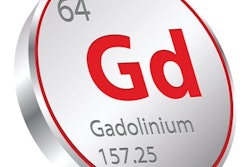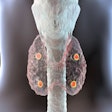
In July, the U.S. Food and Drug Administration (FDA) rekindled the concern over gadolinium-based contrast agents (GBCAs) when it announced it would investigate the risk in the wake of several recent studies that found gadolinium deposits in the brains of some patients years after they received contrast-enhanced MRI scans.
To provide some perspectives on the risk and benefits of GBCAs, a group of U.K. researchers have compiled a series of actions, recommendations, and guidelines in a meta-analysis published online on 8 August in Insights into Imaging.
Low-risk GBCAs should be used judiciously when contrast-enhanced MRI is the most appropriate scanning option after a physician has weighed the risks and the benefits for the patient, according to lead author Dr. Aurang Khawaja, from Queen Elizabeth Hospital in Birmingham. In addition, GBCA dose should be kept to a minimum, given that previous research has linked higher doses with nephrogenic systemic fibrosis (NSF), a debilitating affliction characterized by widespread tissue fibrosis.
NSF has been reported in dialysis patients and individuals with insufficient renal function. Other studies recommend a minimum of seven days between administrations of a GBCA.
Following a gadolinium contrast-enhanced MRI, a 2014 study advises a full four hours of dialysis for patients with renal insufficiency to cleanse their kidneys. Such a procedure was found to clear 88% of the GBCA after 30 minutes and 93% by 90 minutes. After a third session, 99.7% clearance of contrast agent was achieved (Investigative Radiology, August 2014, Vol. 49:8, pp. 505-508).
According to the same study, as much as dialysis helps remove the contrast agent, the procedure cannot reverse any fibrotic tissue formation that has occurred as a result of gadolinium deposition.
Ridding a patient of leftover GBCA is extremely important because "no consistently successful treatment for NSF has been proposed," Khawaja and colleagues noted.
Black box warning
Concern over the link between GBCAs and NSF peaked in 2007 when the FDA ordered GBCA manufacturers to add a "black box warning" to their products, targeting patients with insufficient acute or chronic renal function. The agency's action set a glomerular filtration rate of less than 30 mL/min/1.73 m2 as the standard for giving or avoiding GBCA administration.
Also in 2007, the Pharmacovigilance Working Party of the Committee for Medicinal Products for Human Use (CHMP) recommended the use of gadodiamide and gadopentetic acid be contraindicated in patients with severe renal impairment and subsequently issued warnings for the other GBCAs.
In the following years, organizations and agencies, such as the European Medicines Agency (EMA), the European Society for Urological Radiology (ESUR), and the U.K. Royal College of Radiologists (RCR), published a series of recommendations and alerts on the use of GBCAs.
| European Medicines Agency: Categorization of GBCAs according to NSF risk, based on their thermodynamic and kinetic properties | |
| High risk | |
| A. Linear nonionic chelates | Gadoversetamide (OptiMark), gadodiamide (Omniscan) |
| B. Linear nonionic chelates | Gadopentetic acid (Magnevist, Magnegita, and Gado-MRT-ratiopharm*) |
| Medium risk | Gadofosveset (Vasovist), gadoxetic acid (Primovist) and gadobenic acid (MultiHance) |
| Linear ionic chelates | |
| Low risk | Gadoteric acid (Dotarem), gadoteridol (ProHance) and gadobutrol (Gadovist) |
| Macrocyclic chelates | |
In 2010, the EMA issued its own alert for patients with insufficient renal function and segmented GBCAs by risk into three categories based on CHMP data (see table). The high-risk group included linear nonionic chelates, such as gadoversetamide (OptiMark, Mallinckrodt) and gadodiamide (Omniscan, GE Healthcare), as well as linear ionic chelate gadopentetic acid (Magnevist, Bayer HealthCare Pharmaceuticals; Magnegita, Insight Agents).
The good news is that since 2007, the rate of adverse reactions from GBCAs has decreased dramatically and now only a very small handful of patients have allergic reactions to the contrast agents. And, even those events are relatively minor.
Liver insufficiency
Khawaja and colleagues also noted that past studies found insufficient liver function in and of itself is not a contraindication for GBCA administration. They cited a 2009 study, which found "no compelling evidence to suggest liver disease is a risk factor for developing NSF."
The authors noted that NSF developed only in the setting of pre-existing severe renal insufficiency, regardless of a patient's liver disease status (Journal of Magnetic Resonance Imaging, November 2009, Vol. 30:6, pp. 1313-1322).
The meta-analysis also found "very little data" regarding GBCA use with pregnant women. Given the dearth of data, the authors noted available guidelines recommend "GBCAs should only be given to pregnant women when there is a very strong clinical indication." In addition, breastfeeding should be avoided for at least 24 hours after GBCA administration.
Researchers also advocate additional research to investigate whether greater magnet strength with reduced dose or no contrast agents would accomplish the same patient benefits as current GBCA use.
Diagnostic test accuracy studies also "would aid in clinical decision-making," they added. "Continuing follow-up and research will be needed on low-risk formulations in the long term."



















